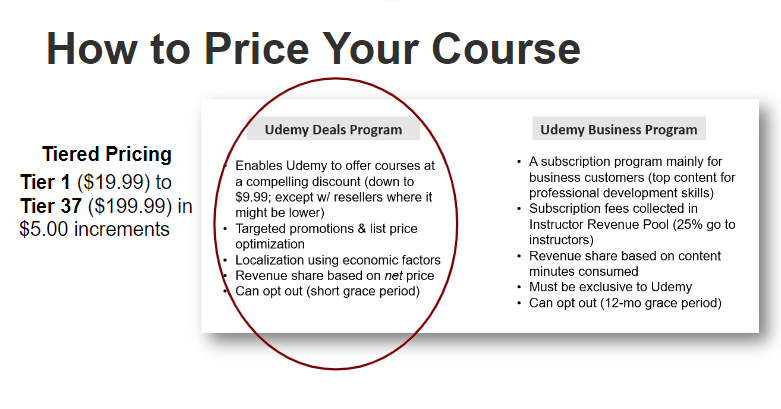
Pricing your Udemy course appropriately is important to attract learners and maximize your revenue. In this post, we’ll walk you through some best practices to help you determine the ideal price for your course on Udemy. Let’s dive in.
Understanding Udemy Pricing Tiers
First things first, let’s understand how Udemy pricing works. Udemy uses a tiered pricing structure that starts at $19.99 for tier 1 and goes up to $199.99 for tier 37. The price increases in $5 increments as you move up the tiers. Additionally, Udemy offers optional programs like the Udemy Deals Program and the Udemy Business Program.
- Udemy Deals Program: This program allows Udemy to optimize your course’s list price, leveraging factors like localization and economic considerations. It’s highly recommended to sign up for this program.
- Udemy Business Program: This program is a bit more exclusive and can be incredibly lucrative. If your course qualifies, it’s advisable to enroll in this program as well. Remember, your revenue share is based on the net price, not the list price.
Pricing Best Practices
Now that we’ve covered the basics, let’s explore some pricing best practices to help you make decisions about how to price your course effectively.

1. Consider Course Length
In general, shorter courses are priced lower than longer ones. It’s a good rule of thumb to keep in mind when determining the price for your course. For instance, courses on the shorter side are typically priced between $19.99 and $49.99.
2. Compare with Similar Courses
Compare your course price with other similar courses on Udemy. This gives you a sense of the market standard for courses in your niche. If most courses in your category are priced around $30, it might be wise to set your price accordingly.
3. Flexibility to Change Prices
One of the advantages of using Udemy is the flexibility to change your course price at any time. This allows to experiment with different price points and strategies to find what works best for your course.
4. Keep an Eye on the Reflection Times
Be aware that the new price you set for your course may not immediately reflect on the Udemy platform or across all devices. It might take a few days for the updated price to be visible to all students, depending on their location and device.
5. Maintain Competitive Pricing
Ensure that the price you set on Udemy is either less than or equal to the price you offer on other platforms. Remember, your course cannot be free or cheaper elsewhere, so maintain consistency in your pricing strategy.
6. Leverage Your Referral Link
Make the most of your unique referral link provided by Udemy. Share this link with potential students, and if they purchase your course within 24 hours of clicking the link, you’ll be credited with the sale, maximizing your revenue share.
7. Harness the Power of Coupons
Udemy allows you to use coupons to attract students. You have three coupons every month, so use them strategically to offer discounts and entice more learners to enroll in your course. People love a good deal, and coupons can be a powerful tool to drive sales.
If you’d like to learn more, check out “Create & Sell an Online Course on the Side” to learn how to publish bestselling courses on Udemy